ISSN ONLINE(2319-8753)PRINT(2347-6710)
ISSN ONLINE(2319-8753)PRINT(2347-6710)
Puneeta Ajmera1 , Dr. Mahavir Singh2 , Dr. H.K.Satia3
|
| Related article at Pubmed, Scholar Google |
Visit for more related articles at International Journal of Innovative Research in Science, Engineering and Technology
Strengths, Weaknesses, Opportunities and Threats (SWOT) analysis is a popular tool which examines strengths and weaknesses (internal factors) of an organization or industry together with opportunities and threats (external factors) of the marketplace environment. SWOT analysis is the best method to provide the basic outline to take strategic decisions. In this study, we have integrated SWOT analysis with multicriteria decision making technique called Analytic Hierarchy Process (AHP) to rank different strengths, weaknesses. opportunities and challenges of Indian medical tourism in order of prioritization. In AHP approach pairwise comparisons among factors or criteria is performed in order to prioritize them using the group priority scores calculation. The objective of using the integrated SWOT AHP method is to improve the quantitative aspect of strategic decision making process.
Keywords |
| SWOT Analysis, AHP, Strategic decisions, Multiple Criteria Decision Making Technique, Medical Tourism |
INTRODUCTION |
| Healthcare industry is among one of the most rapidly growing industries in the world economy and is continuously faced by new issues and challenges. Healthcare systems have to respond to different challenges caused by cross border trade in delivery of health services through movement of healthcare service seekers, providers of healthcare services and different joint ventures and collaborations. (Chanda R, 2002) Now a days cross border trade is considered to be one of the best ways to create and finance the additional resources for healthcare industry in the developing nations of the world. (Siddiqi et al, 2009) New opportunities and challenges has been created by liberalization of trade in healthcare sector specially in middle and low income group nations to provide remarkable and efficient healthcare services. (Siddiqi et al, 2009) |
1.1 Modes of supply of healthcare services |
| According to General Agreement on Trade in services (GATS) definitions, there are four modes of supply as far as trade in healthcare services is concerned. (Chanda R, 2002) They are listed as MODE -1 Cross border delivery of trade MODE – 2 Consumption of health services abroad MODE – 3 Commercial presence MODE – 4Movement of health personneld |
1.1.1 Cross border delivery of trade |
| This mode includes electronic delivery of healthcare services like pre and post care consultation and diagnosis which is also referred to as telemedicine services as well as movement of lab samples. Telemedicine or telehealth services includes the use of audiovisual aids and different data and information communication techniques to provide health services around the world at a distance by specialized clinicians. (Chanda R, 2002) |
1.1.2 Consumption of health services abroad |
| This mode includes movement of patients to different countries for seeking medical procedures. Most of the times patients from underdeveloped countries or developing countries move to developed countries with better health care facilities for high quality treatment procedures or alternative medicine. (Chanda R, 2002) For example India is famous for high quality medical procedures at competitive prices and alternative medicine like yoga and ayurveda. |
1.1.3 Commercial presence |
| This mode involves setting up hospitals, diagnostic centers, clinics in different countries. Various countries like India, Nepal, Thailand are open to foreign direct investment. For example a German company has been given approval to set up a 200 bedded hospital in Delhi and thus having 90% foreign equity ownership. Different Indian and foreign companies are collaborating to establish multispecialty hospitals in India. |
1.1.4 Movement of health personnel |
| This mode includes the movement of health practitioners like doctors, nurses, paramedical professionals, technicians, trainers etc. from their home country to other countries. Various reasons causing cross border movement of healthcare professionals include wage differences between different countries, search for better exposure, training and better standards of living as well as good working conditions (Chanda R, 2002). This mobility seems to be more in nursing profession which consists of 70% healthcare staff and 80% of direct patient care services. There is imbalance between demand and supply in nursing profession (Cohen A, 1997). |
| 1.2 Objective of the study: In this study, we have focused on current strengths, weaknesses, opportunities and challenges of Indian medical tourism (from the attitude of providers). The main objective of this research is to rank the strengths, weaknesses, opportunities and threats of Indian medical tourism and in this way to help policy makers so that they can allocate their resources in the best manner and use this ranking in their decision making process. |
II. SWOT Analysis & AHP |
| 2.1 SWOT Analysis SWOT (the acronym standing for Strengths, Weaknesses, Opportunities and Threats) is a popular tool to analyze the internal and external environments of an organization to achieve a scientific and systematic approach to take strategic decisions. (see, e.g., Wheelen and Hunger, 1995, Hill and Westbrook, 1997). As far as strategic factors are concerned, the internal and external factors are the most important factors for an organization’s future. In SWOT analysis these internal and external factors (also called SWOT factors) are categorized into four groups called SWOT groups: strengths, weaknesses, opportunities, and threats. |
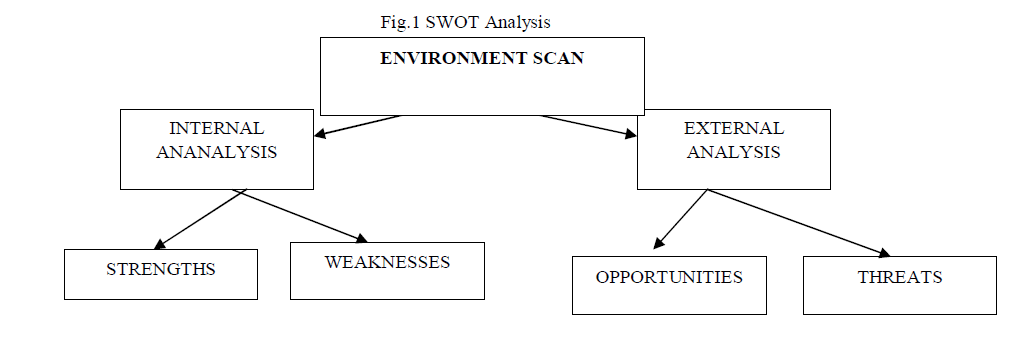 |
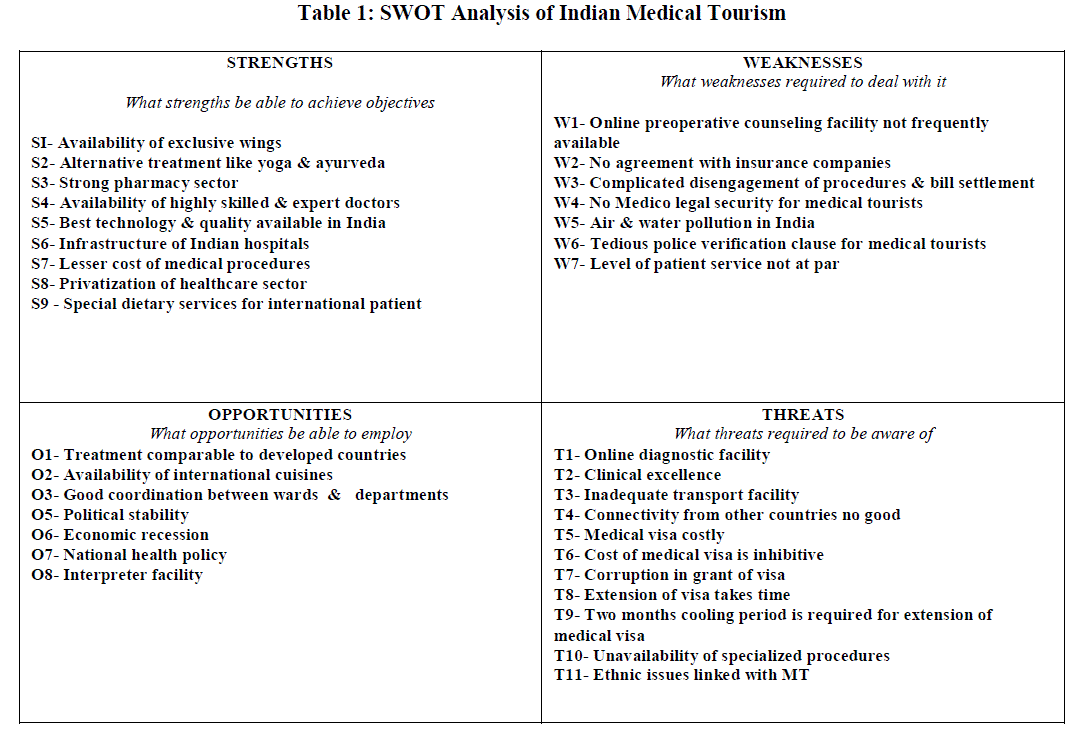 |
2.2 AHP |
| The primary step in the AHP technique is that a complex issue is divided into a structural (hierarchy) and aims & criteria are added (Boroushaki & Malczewski, 2008.) Aim is added at the top of the structure while criteria and sub criteria are put in the levels and sub-levels and decision alternatives are placed at the bottom of the structure. The objective of integrating the Analytical Hierarchy Process (Saaty, 1977, 1980) with a SWOT framework is to do a systematic evaluation of the SWOT factors and make them consistent and appropriate according to their priorities (Kurttila et al., 2000). In SWOT analysis, the AHP’s qualities are considered to have a valuable contribution. To add additional value to SWOT analysis pairwise comparisons between the SWOT factors are performed and analyzed with the help of the eigenvalue technique as a component of AHP. |
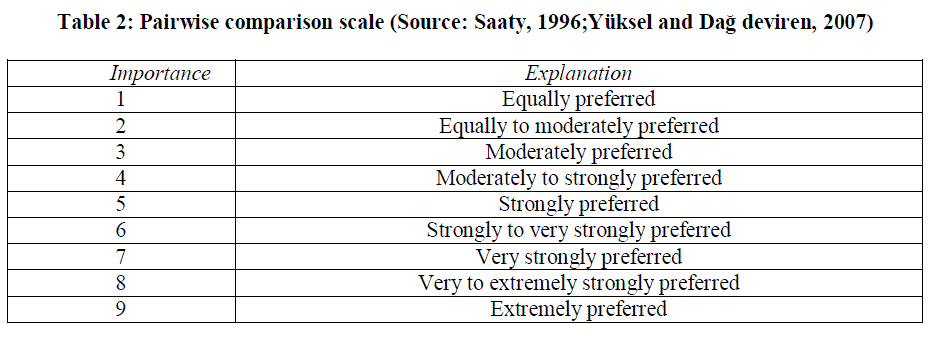 |
2.3 AHP and SWOT |
| In AHP technique, pairwise comparisons between different evaluation factors is carried out in order to prioritize the factors using the eigen value calculation. In SWOT analysis, the weights of the factors are not taken into consideration to find out the effect of each factor on the proposed strategy alternatives (Yüksel,I. andDaÃâßdeviren, M. 2007). SWOT analysis alone does not systematically determine the relative importance of the criteria. In order to overcome this insufficiency, the SWOT matrix is converted into a hierarchic structure and is integrated with AHP to find out the priority scores.(Kangas, J., Pesonen, M.,Kurttila, M. and Kajanus, M. (2001). This method quantify the SWOT factors systematically by equating their priorities. Wickramasinghe, V. and Takano, S. (2010). The proposed method involves three steps |
| ïÃâ÷ The first step is to enumerate and list the considerable internal (strengths and weaknesses) and external (opportunities and threats) factors for the strategic planning thereby making a SWOT framework. (Figure 1, Table 1) |
| ïÃâ÷ In the second step, pairwise comparison is done to calculate the weights of each SWOT group using Saaty’s scale.(Table 2, 3). The prioritization process is obtained by assigning a number from a comparison scale developed by Saaty (1980) to add the relative importance of the criteria(Table 2). |
| ïÃâ÷ Finally in the third step, AHP technique is used to calculate the relative priorities of each factor within SWOT groups. Then the factors local weights are multiplied by specific group weight to calculate the overall factor weight rank. (Tables 5,6,7,8,9) |
IV. DATA COLLECTION & ANALYSIS |
3.1 Data Collection |
| A group of ten doctors, coordinators of international wings and top management personnel of three hospitals of Gurgaon were selected which includes Medanta Medicity Gurgaon, Artemis Hospital and Max Super speciality hospital Gurgaon. After several rounds and sessions of discussion, they ended up with nine strengths, nine weaknesses, eight opportunities and eight threats to consider in the strategic planning process. Let A = {Aj| j = 1, 2, . . . ,n} be the set of criteria. The final result of the pairwise comparison on n criteria can be summed in an (n x n) matrix C in which every element a ij(i, j = 1, 2, . . . ,n) is the quotient of weights of the criteria. This pairwise comparison can be depicted by the following equation: |
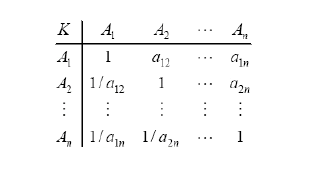 |
4.2.Data Analysis: |
3.2.1 AHP Calculation: |
 |
The Consistency Ratio (CR) indicates the consistency in making the pair-wise comparisons. Calculating the Consistency Ratio (CR) is a four-step process. |
| ïÃâ÷ First, the pair-wise comparison values in each column are added together (as the “Sum” values) and each sum is then multiplied by the respective weight (from the “Priority vector” column) for that criteria. The row labeled “Sum PV” shown in the matrix above. shows the result of multiplying the respective sum (shown in the row immediately above) by the respective weight for that criteria (shown in the column labeled “Priority vector”). |
| ïÃâ÷ In the second step, the aforementioned values (shown in the row labeled “Sum*PV”) are added together to yield a total of 4.1317 (i.e.,1.0058+ 1.1823 + 1.0076 +0.936= 4.1317). This value is known Lambda-max. ïÃâ÷ In the third step, the Consistency Index (CI) is calculated. |
| The formula is: CI = (Lambda-max –n) / (n–1) where n is the number of criteria or systems being compared. In this case, n= 4, for the three different criteria being compared. For this particular case, the calculation is: 4.1317-4 /4 =0.032 |
| ïÃâ÷ In the last step, Consistency Ratio (CR) is calculated by dividing the Consistency Index (CI) (from the previous step) by a Random Index (RI), which is determined from a lookup table. The Random Index (RI) is a direct function of the number of criteria or systems being considered.(Table 4) |
 |
| The matrix will be consistence and acceptable if consistency ration is less than 0.1 or )1.0 (CR ≤ , if not we have to revise the subjective judgement. |
| ïÃâ÷ In general, the Consistency Ratio (CR) is calculated as: Consistency Ratio (CR) = Consistency Index (CI) / Random Index (RI) `In this case, n= 4 because four criteria are being compared, and so the Random Index (RI) equal to 0.90 (from the table) must be used. Therefore, CR = CI / RI = 0.039/0.90 = 0.03. ïÃâ÷ The Consistency Ratio (CR) tells the decision-maker how consistent he/she has been when making the pairwise comparisons. If the Consistency Ratio (CR) <0.10, the decision-maker’s pair-wise comparisons are relatively consistent. In this case the CR equals 0.03, which means that the pairwise comparisons are relatively consistent and no corrective action is necessary.) |
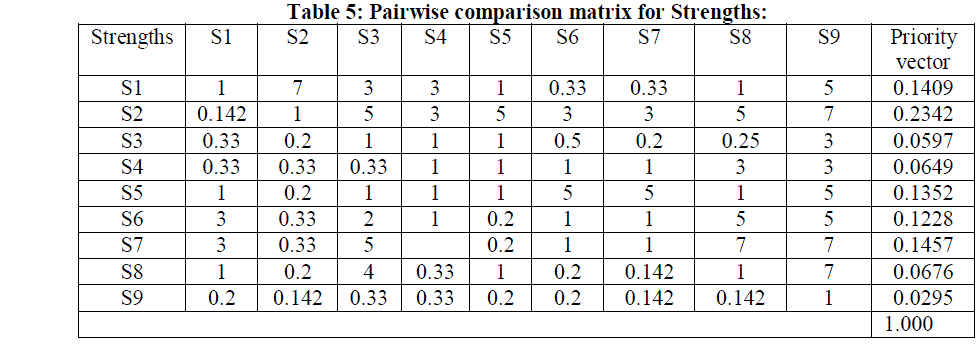 |
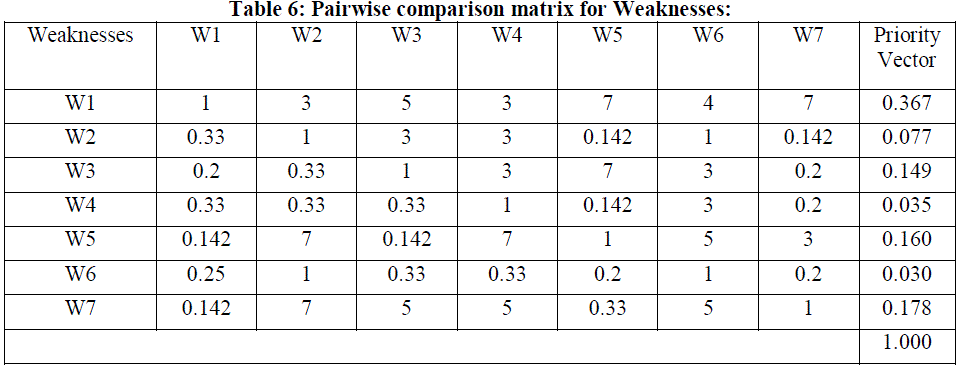 |
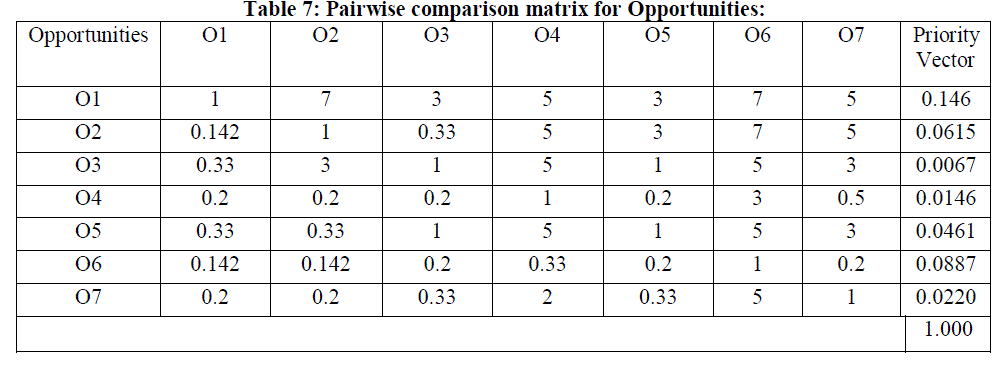 |
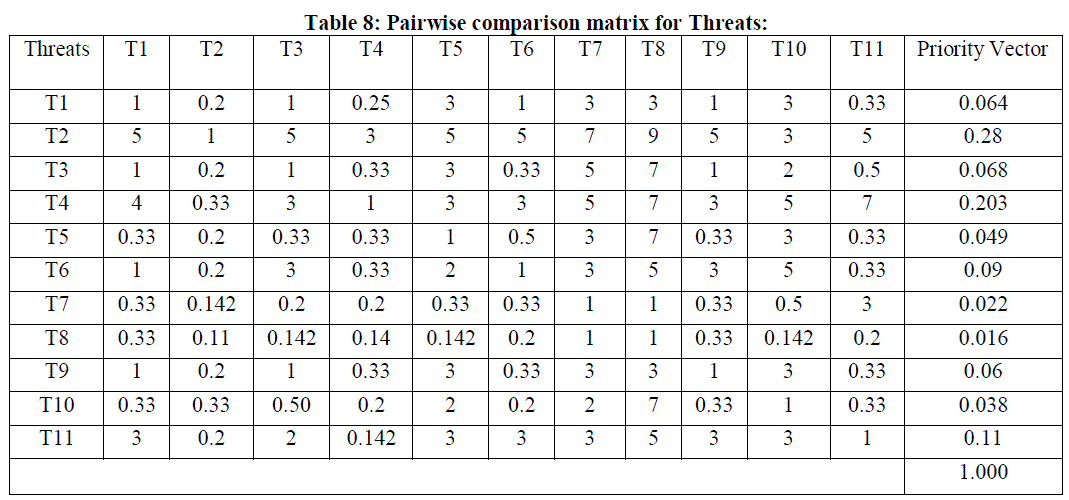 |
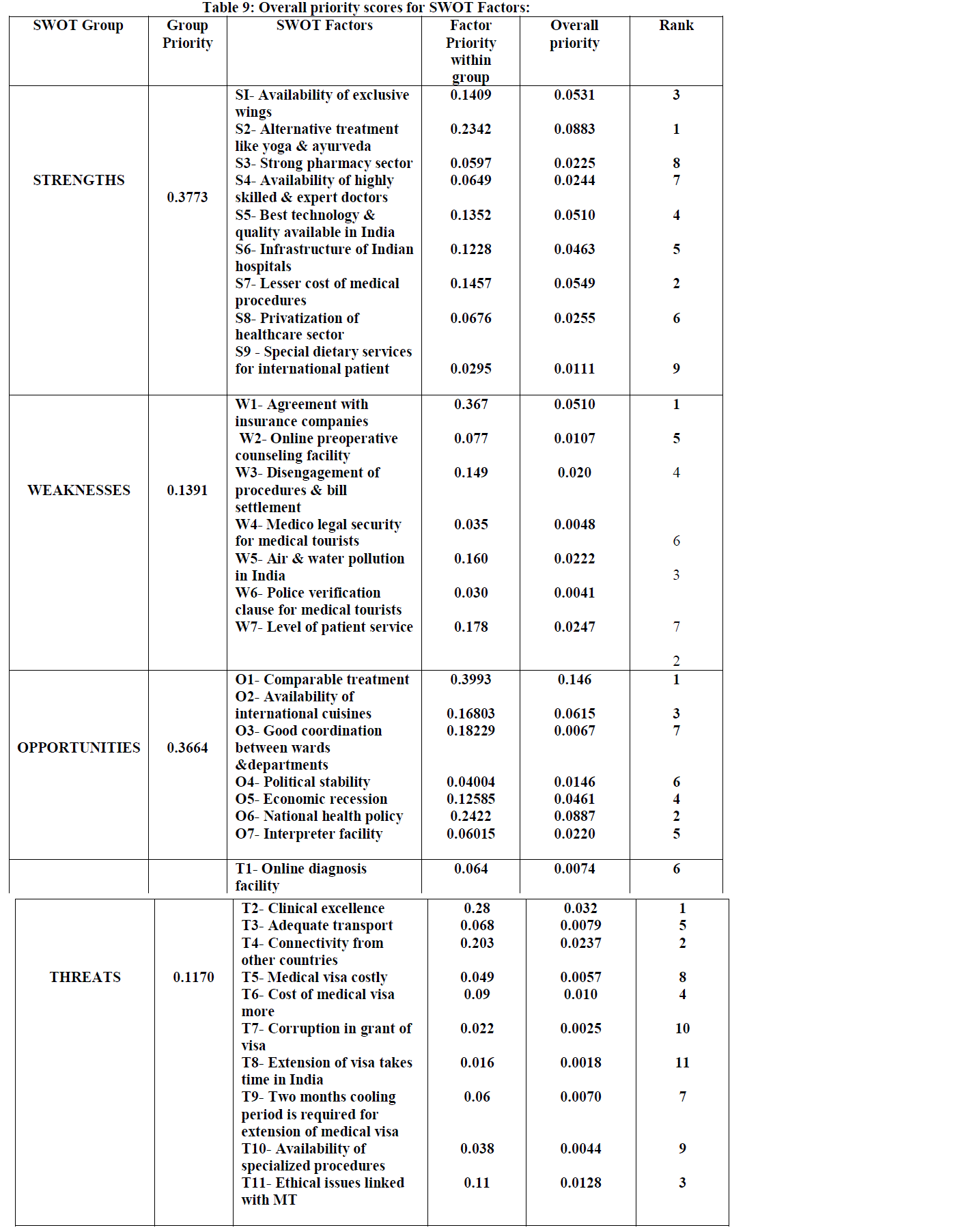 |
V. RESULTS |
| Data obtained from the questionnaires was entered in excel and prioritized using Multiple Attribute Decision Making (MADM) approach (AHP method). The judgments of subjects were varied in form and depth. While one may not indicate his/her preferences at all, another may represent his/her preference through some alternative or attribute. Also degree of judgment skill also varies. To meet this varied situational judgment multi attribute decision making methods (MADM) because of the structure of questionnaires that included various factors under strengths, weaknesses, opportunities or challenges and AHP is a multi-criteria decision making method that utilizes hierarchical formation to show a problem and then develop priorities for alternatives based on the decision of the user (Saaty, 1980). AHP has been developed by Thomas Saaty in 1970 to assist decision makers to solve unstructured problems in social, economic, military analysis and, management science. This method is an appropriate method for complex decision that involves the comparison of decision |
| In this study, in the first step strengths, weaknesses, opportunities and challenges of globalization of health in context to India were identified. Challenges are all factors restricting entering this industry which may be an unfavorable condition in the industry’s environment which creates a risk for, or causes damage to, the Indian medical tourism industry. Strengths and weaknesses look inward at the resources and experiences of the industry. Strength is an inherent capacity which an industry can use to gain strategic advantage. A weakness is an inherent limitation or constraint which creates strategic disadvantages. An opportunity is a favorable condition in the service industry which enables it to consolidate and strengthen its position. In this way, 9 strengths, 7 weaknesses, 12 opportunities and 11 threats were identified. In the other step with AHP method data was prioritized for the strengths, weaknesses, opportunities and challenges of Indian Medical tourism. |
VI. DISCUSSION & CONCLUSION |
| In this paper, we have determined significant strategic factors to organization by combining SWOT with AHP techniques. The findings show the ranking of each SWOT group priority. |
| SWOT analysis of medical tourism sector in India show that as per international patients perspective alternative treatment facilities like yoga and ayurveda has emerged out to be the biggest strength and cost of medical procedures which is comparatively lesser than developed countries is ranked as the second biggest strength. India offers ample opportunities in the medical tourism sector as it offers cheaper treatment in comparison to developed countries like USA and UK where 46.6 million people are uninsured and apart from high cost of medical treatments there are long waiting lists for surgeries for UK patients (Starr Sered and Fernandopulle, 2005; Aston, 2006; Milstein and Smith, 2006a; Horowitz, 2007). Infrastructure of Indian hospitals at par to that of developed countries along with provision of exclusive wings for medical tourists are another strengths. Medical tourists choose India as their favorable destination because of the key opportunities in Indian healthcare sector in the form of efficient infrastructures and technology. Skilled and expert workforce in Indian hospitals is another strength which is able to handle any type of medical complications. Most of the doctors and surgeons at Indian hospitals are trained or have worked at some of the medical institutions in the US, Europe, or other developed nations. Indian nurses are among the best in the world. |
| Pharmacy sector in India is ranked eighth in strengths in Indian hospitals. Dietary services is the area which is ranked least by the subjects enrolled for measuring Indian hospital perspective of globalization of health showing that food service area needs improvement as per the demands of medical tourists from different countries. As per information provided by the subjects around 35% of medical tourists were not happy with the quality of food served. Companions of the patients also suffered the same problem indicating that this area has to be seriously looked upon. No agreement of hospitals with insurance companies for medical tourists was ranked first as weakness of Indian medical tourism. Only some of the hospitals in India have tie ups with insurance companies which makes treatment difficult to afford for medical tourists. Another weakness of Indian medical tourism is police verification and provision of medico legal security for medical tourists. The medical visa category has been recently introduced in India but, due to the cumbersome police verification clause, the International Patient Service division in hospitals recommends that foreign patients fly on a regular tourist visa. Extension on medical visa is granted on medical grounds only thereby warranting the stay of the patient in India for urgent medical attendance. One threat of globalization of healthcare services with regard to Medical tourism industry is the area of public sector health inequity. Private hospitals mainly cater to medical tourists causing a brain drain of workforce from public to private hospitals. Comparatively high level of problems are reported by medical tourists pertaining to factors such as air and water pollution, heavy rush, beggars, health care and sanitary conditions. |
| National Health Policy of 2002 for promoting medical tourism in India is better suited for primary and secondary care rather than tertiary medical care. There is monopoly of private enterprises in medical tourism sector and the Government participation is very less in promoting it. Political stability in India combined with experienced, skilled consultants and infrastructure of Indian hospitals at par to developed countries with internationally acclaimed superspecialists are the major growth drivers of Internationalization of Indian Healthcare services. Results of this study can be used for the developing appropriate strategies for medical tourism sector in India. In future research, fuzzy logic framework can also be used with the AHP method to analyze the results more effectively. |
References |
|